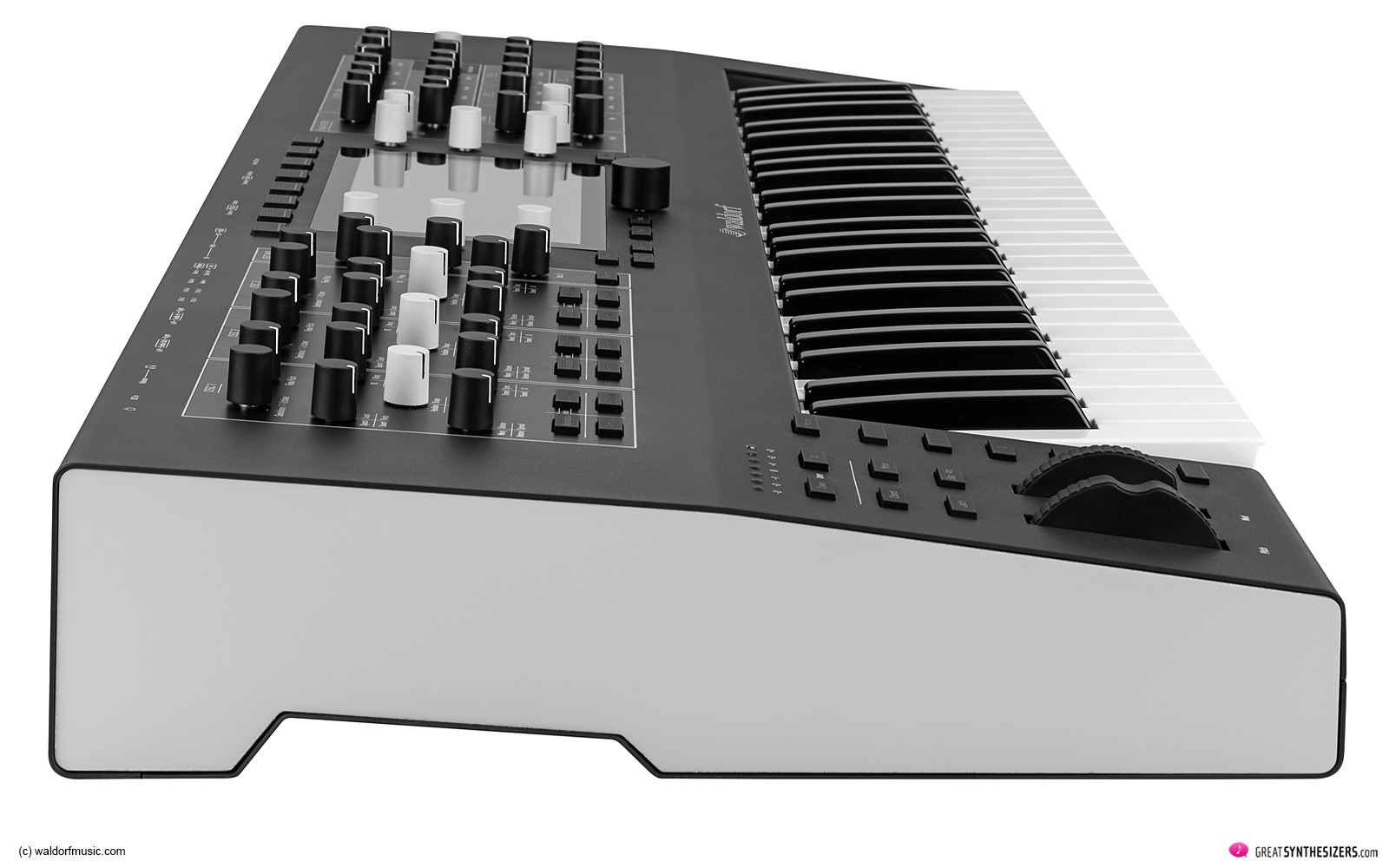After introducing Iridium synthesizer in a compact desktop form, Waldorf takes the concept further forward with the Iridium Keyboard. It boosts a 49-key FATAR TP/8SK semi-weighted polyphonic aftertouch keyboard, an expanded front panel (one-knob-per-function controls) and six freely-programmable Macro buttons.
There are – like with the desktop version – a large number of filter types (including a dedicated “Quantum” filter type), sequencer, arpeggiator and, in addition to the classic digital connections , various CV/gate connections.
Unchanged: The 16-voice polyphony. Also unchanged: the digital filters. New: The luxurious surface. The keyboard with polyphonic aftertouch. Macro buttons for flexible performances.
FEATURES
Waldorf Iridium Keyboard
- 16-voice polyphony, duo-timbral
- Compatible with the Waldorf Quantum synth engine
3 Oscillators
Oscillator Modes:
- Wavetable
- Waveform (VA)
- Particle (Sampling and Granular Sampling)
- Resonator
- Kernels (up to 6 sub-oscillators which can be interlinked through FM at audio rate)
3 Stereo Filters per voice
True stereo path
Dual Digital Filter:
- Two filters with independable modes
- 12/24dB LP/HP/BP in all combinations
- Nave, Largo, PPG, Quantum and StateVariable models
Digital Former:
- Filter models from Waldorf Nave, Largo and PPG in HP/LP/BP/Notch
- Comb filter
- Bitcrusher
- Drive
- RingMod
- StateVariable mode
- Analyzer displayed in Filter view
- Filter curve moves when modulated (optional)
- Sophisticated filter routing options with modulatable panning and levels
Modulators:
- 6 Envelopes
- 6 LFOs
- Komplex Modulator (LFO/Envelope combination with user-definable shape)
Mod Matrix:
- 40 slots
- Fast assign mode
- One additional control amount per slot
- Identical Sources and Destinations can be used multiple times until the matrix is full
Keyboard:
- 49 keys Fatar TP/8SK keyboard
- Semi-weighted sensitive keys with polyphonic aftertouch
- Latch mode
Performance features:
- Arpeggiator
- Step sequencer with up to 32 steps for notes and parameters
- Favorites screen for quick patch recall
- Mod Wheel, Pitch Bend and Poly-Aftertouch
- MPE capable
- 6 Macro buttons (six freely-programmable buttons to switch on and off functions)
Screen:
- Industrial-grade highly responsive touch screen
Patches:
- Over 1000 factory sounds
- Capacity of 7000 patch memory slots (numbers 0000-9999 can be used)
- Patches from Quantum can be loaded and vice-versa
- Category filter for patch list
- 2GB user sample flash memory
Connections:
- 2x TS output
- 2x TS input
- Headphones output with Gain control
- DIN MIDI In/Out/Thru
- USB Type B for MIDI connection to computers / DAWs
- USB Type A for direct connection of storage devices and MIDI controllers
- MicroSD slot
- Kensington® lock
CV connections:
- 4 CV inputs plus Gate In, Trigger In, Clock In, Clock Out
- Inputs can be used as modulation sources in the Mod Matrix
Overall:
- Sturdy metal case
- Dimensions: 851 mm wide by 355 mm depth by 110 mm height (including controls)
- Weight: 14 kg
Iridium keyboard contains 1680 sounds from first-rate sound-designers such as Howard Scarr, Richard Devine, Kurt Ader, BT, Matt Johnson, Reinhold Heil, Jörg Hüttner, Mike Huckaby, Thorsten Quaeschning and Sascha Dikiciyan.
Video 1:
Video 2:
Waldorf Iridium Keyboard
16-voice duo-timbral synthesizer
3 oscillators, 3 stereo-filter per voice
digitaler former (Bitcrusher etc.), mod-matrix (40 Slots)
sequencer, arpeggiator and a keyboard with polyphonic aftertouch
Price:
2.849 Euros
Link:
www.waldorfmusic.com








